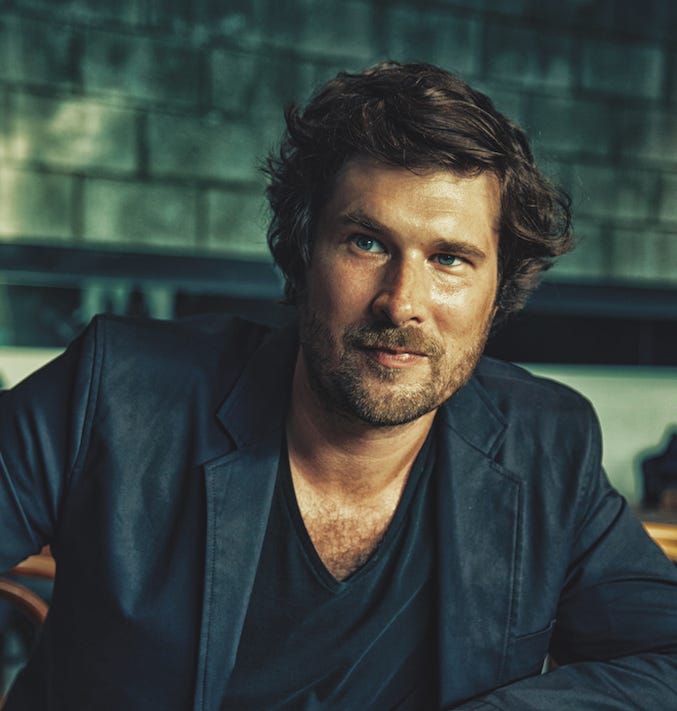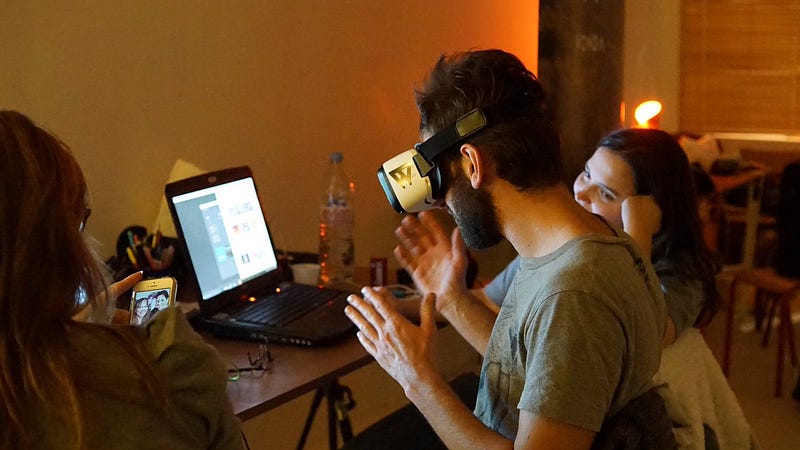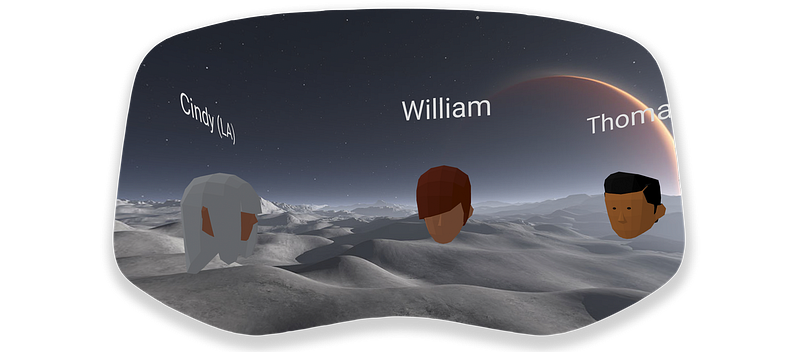Q&A: Arnaud Dressen of Wonda VR
The CEO and founder discusses how to navigate transitions in the immersive documentary field, sharing industry trends and insights
 Founder and
CEO of Wonda VR, Arnaud Dressen
Founder and
CEO of Wonda VR, Arnaud DressenArnaud Dressen is a specialist in new forms of nonfiction storytelling who works with content creators, institutions, and brands to explore the expanded possibilities enabled by new technologies. He founded and leads Wonda VR, a content production tool for educational institutions and businesses to create immersive VR spaces for shared learning.
Dressen’s previous experiences in interactive storytelling guide his approach to VR as a medium that connects different fields and audiences in a unique way. After collaborating with journalists, directors, and independent producers through his digital media production studio Honkytonk Films, Dressen found the need for creators to be more autonomous in digital media production, an effort that led to Klynt, an interactive video editing and publishing software. Now, with Wonda VR, Dressen hopes to expand VR toolkits in education and business that focus on more targeted audiences and objectives but allow for methodological experimentation in storytelling itself.
Open Documentary Lab Research Assistant Andrea Kim discussed the project with Wonda VR Founder and CEO Arnaud Dressen. The conversation has been edited and condensed for space and clarity.
Could you discuss your transition from making tools for web documentary to making those VR? How are they alike and similar, and how does that reflect shifts in our time?
I discovered VR while working in interactive documentary. It was kind of a dream medium for what we were doing, by including cinematic and interactive components. So I wanted to create a new company dedicated to virtual reality and immersive storytelling with a strong focus on education and learning: Wonda VR. Right away, it was a creative platform where a community of content creators, businesses, universities, could join, create and share interesting learning experiences.
 Workshop
participant at 2018 Wonda VR Film Jam
Workshop
participant at 2018 Wonda VR Film Jam
Both web documentary and VR require very specialized tools to create interactive experiences using various media such as photos, sounds, videos, 3D objects, and even data visualizations. Combining pieces in a comprehensive, logical manner is often very difficult. Or you have to learn how to code, learn to use VR game engines. In the case of Klynt, my first software launched in 2012, it’s about how you can ease the process of creating an interesting immersive presentation wherever the user is at the center of the experience. Now, the shift to VR has happened, and the new thing is really about the sharing and collaborative component , specifically with the new platform Wonda VR Spaces, which is focused on collaboration within, so that anyone within an organization can collaborate more easily than before.
It’s a very different approach from having one person using a tool and then exporting the project and sharing it. With Wonda VR Spaces, the whole creative process is open and collaborative, a platform where you can be an author of a project as well as a viewer. You can both discover and create projects. This collaborative aspect is very, very important.
I think the focus on training and learning has always been a very important part of interactive storytelling, but Wonda VR has a very pragmatic way of looking at who is funding it, who is most likely and most willing to invest in this technology on a very broad scale. Universities and businesses are the first to invest in this technology.
Consumers are getting there. But, again, this is also my journey of understanding how we can organize the model of a platform so that you can use and fund it. I come from independent documentary production. I’ve been growing up and understanding where the money is spent. You have hundreds of billions of dollars spent on training and teaching, so that’s maybe where there’s something to do. And, yes, this content hopefully can also eventually be shown in media and journalism. But, this is really where I see that there is the most potential right now in terms of like finding the financial resources for the creative community to do something interesting in terms of the type of content.
Many people don’t realize the dimensions of VR in the collaborative, production, and creation process in university or business spaces. Could you speak a bit more about the importance of that?
I would say it’s a very strong trend in universities, businesses, and organizations towards more interdisciplinary approaches because the problems that we are facing are changing faster. So, there’s a need to break the silos and boundaries that have been traditionally set in, I would say for the last 50 years. Virtual reality, in many ways, needs interdisciplinary practices to evolve and grow. When I started with interactive storytelling on the web, we were already talking about how it was important to have a tool where people coming from content, from design, from business and education could be working together.
With virtual reality, it goes even one step further with architecture, with theater, and set up an environment for the story to unfold so that viewers are going to innovate in a way that they never did in the physical space. So, you’re looking at even more disciplines that are so useful. For example, we are now looking at partnering with architectural designers and sound designers to design the new spaces to offer as templates or default environment for our users. It’s something we would have not done before.
It’s an evolution towards a fully immersive, personal storytelling experience that we’ve seen going from the web to mobile to virtual reality. I love working with so many different bodies of work and expertise.
 Wanda VR supports social
immersive experiences
Wanda VR supports social
immersive experiencesIs there a story or project that made you feel like this tool enabled people to collaborate in a way that probably wouldn’t have happened otherwise?
I hear people talking about using virtual reality and using our platform to grow people’s intuitive skills. I’m talking about projects where you have people with Alzheimer’s or dementia using our platform and the multi-user component where you can synchronize the experience between different people that are onsite and remote.
So, you have a patient that is maybe 75 years old working with a caregiver who’s 20 years old and doesn’t know the patient. You can have a family member come to the hospital and help build this project where the family member puts together a memory experience of collecting photographs and videos and putting this into a sphere in which the father or grandfather can go inside, immerse himself into the experience. Then, he can talk about it with the caregiver, so they can interact in different ways by just having this memory recollection and the ability to also convey and connect with family members. I found that very interesting when I was using it.
Another idea is in remote working. How do you work in a meaningful way when everyone is working from different locations? With a remote team today, video conferencing can be frustrating. Slack and chat is kind of cool but there are no real human connections. How do you recreate creative discussions when you are not physically in the same space? How do you create this moment where you just bumped into someone and go and grab a coffee outside?
Some people are doing very interesting stuff with it in Wonda VR. Like setting up like a brainstorm session on a cloud overlooking a city, where you want to think about the transportation system, using it as a context to think about a problem.
However, as with any platform, there are limitations. You cannot do everything you want as a creator. There are creative constraints. So it’s the very beginning. We just released the new platform six months ago. We started with 360 video and now we’ve added 3D environment and 3D objects. So it’s the beginning of another third kind of staging, from Klynt, to Wonda VR interactive 360 video, to something more about the environment — and how you can not only set interactive presentation and position, but also design the context in which you want this presentation to be shared.
Can you speak more to the type of attitude that you think VR can inspire in creators and its users to address new problems?
It’s a well-known creative building technique to change environments. It’s often said, “Why don’t we go to some other place, go out of the office, out of the classroom to think about something differently?” With VR, you have so much more freedom in terms of what you can do because you can go in abstract places, see things impossible to see in real life. That brings another level of possibility in terms of how you can strike new ideas by putting people more creatively into new environments.
Imagine five to ten years from now, what would it mean for people to collaborate in virtual reality from all over the world? That’s feasible, technically. I don’t see why it would not happen. But can you imagine the possibilities in terms of going beyond the physical limitation of our world to define and create a more fruitful and collaborative environment for people to solve today’s problems quickly?
I’m thinking about the audience of storytellers who are on the fence about trying out VR, but might have some preconceived ideas about VR and its accessibility. What would you say to these audiences? And how do you think they can benefit from VR?
People are starting to say, “Yeah, this is the moment, VR is happening.” It was too soon five years ago before the arrival of standalone headsets, too early. I would say that if you are looking at the tools and possibilities as of today, it’s a great time to start investing in the space.
The VR headset is now comfortable enough to use, although there are still some glitches in terms of resolution or size and weight of the device. It’s good enough for people to spend one hour experiencing Tribeca projects or the amazing games available — to really understand the potential of the medium and be inspired by it.
The question is whether or not you want to invest in the technology and start creating projects now. There’s decent funding from the hardware manufacturers for independent storytellers specialized in virtual reality, And if you’re looking at education, that’s where I think you can find funding easily.
I would say to be very pragmatic about how you can apply your creativity and talent to something that’s actually going to be used by students or employees before you have a target audience in mind. And then yeah, there are festivals. I think it’s amazing that this whole space has been growing so fast in the last 10 years.
To me, it reminds me of the beginning of the interactive documentary wave. The fact that it’s interactive or immersive doesn’t change that funding is very limited. You need a very strong commitment because it’s complicated and requires a lot of personal investment. I strongly believe in independent creation, but the kind of change in the way I’ve been approaching that is to be more realistic about the buy-in.
What I know for a fact is that people feel often stuck in classrooms. They feel stuck in corporate training rooms and have poor learning content to watch. So I know people might consider education and training as totally separate from the creative space. But there are so many amazing things to do. People are looking at VR as a way to get a new generation of content because they don’t want to have the same kind of textbook, like in French culture for a language course in VR. We want to have something way more authentic because that’s what the medium promises and expectations are high and the money being spent now on this kind of content is real.
All these barriers you mention: Would you say this is the purpose of tools like Wonda VR? What is the role of tools in addressing these challenges?
There are so many different tools you can use to create a VR experience. You can create an immersive film just by using 360 videos and use the same video editing tool that you’ve been using for before with a 360 plugin. If you want to do more in a 3D environment, interactive stuff, you can try game engines that are more complex to get in.
If you don’t care about distribution, that’s fine. If you want to do a prototype with a game engine and distribute it to your friends, that’s cool. Otherwise, your target audience and how you want to reach them is what should drive your decision of what tools to use, because the reality is that you need to deploy it as an application when using game engines, which is wrapped with many other questions.
Could you speak more to the VR industry, and how creators need to consider the link between distribution and tool?
You are having the same problem of distribution that you had in the early days of mobile platforms. There are very few actual applications in the app stores. So, distribution is a real issue. That’s also why we invested so much on web XR and open technologies, so we could provide the freedom to anyone to deploy their projects wherever they want, when they want. That comes with constraints but if your constraints boost distribution then I think that’s worthwhile. Time is another interesting constraint also to consider. How much time do you want to put it in a project? I’ve been working on three-year long projects and productions as well as two-day projects and from start to finish. As the technology is evolving very fast, I believe this is good to work in short iteration cycles.
Immerse is an initiative of the MIT Open DocLab and The Fledgling Fund, and it receives funding from Just Films | Ford Foundation and the MacArthur Foundation. IFP is our fiscal sponsor. Learn more here. We are committed to exploring and showcasing media projects that push the boundaries of media and tackle issues of social justice — and rely on friends like you to sustain ourselves and grow. Join us by making a gift today.